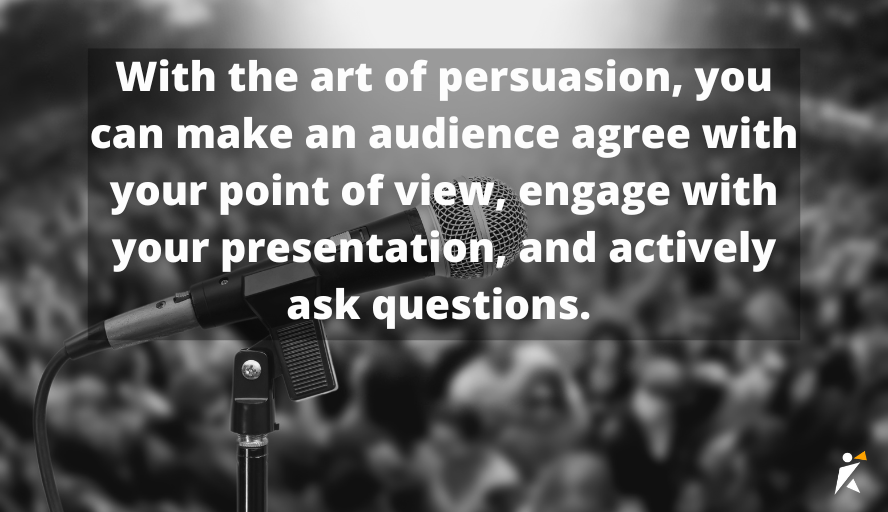Mastering the Art of Persuasion: Top 10 Practical Techniques for Effective Public Speaking

Do you know how old the art of persuasion is? It all started four centuries before the common era with Aristotle’s work called Rhetoric. In his writing, he spoke about the power of words and how to use them for persuasion.
In modern times, rhetoric is still the foundation for public speaking as it’s a method of persuasive communication. Mastering the delicate art of convincing and engaging people is a powerful asset when speaking to a large audience.
Today, our goal is to guide you through the depths of effective persuasive techniques that can enhance your public speaking skills.
But first, let’s start with the basics.
The Basics of Persuasive Speech

Persuasive speaking comes naturally to some people, while those who are eager to speak publicly in a compelling way can learn it. With the art of persuasion, you can make an audience agree with your point of view, engage with your presentation, and actively ask questions. You can have a real discussion with interested listeners.
An effective public speech aiming to convince must be succinct, straightforward, and argumentative. Moreover, you should avoid complicated wording, incomprehensive language, and academic terminology.
10 Practical Techniques for Effective Persuasion
The main objective of persuasive public speaking is to inspire the audience to take a desired action by comprehensively explaining your viewpoint.
Let’s see how to do that effectively:
1. Believe in your credibility
It’s so much easier to present to others when you’re confident in your authority as a public speaker. Showcase your expertise at the beginning slides of your presentation so your audience can assess you right away. However, start your speech with a hook, not your credentials. They’ll see them in the slides anyway. We’ll explain why in the next point.
2. Master storytelling
Everyone loves a good story. Use the first 30 seconds of your public speech to position yourself as an authority by telling a compelling story about yourself. A story related to the presentation topic will immediately grab the listeners’ attention. The audience will be more likely to listen actively.
3. Convince but don’t trick listeners
It’s crucial to be honest with your audience and not be manipulative. Persuasion is all about what’s in the best interest of those listening and letting them decide how to act. Conversely, manipulation is tricking someone into doing something that won’t benefit them. Be careful not to cross that line because you may appear dishonest.
4. Show interest in your audience, and they will give it back to you
We, humans, are most interested in ourselves. We constantly think about past, present, or future events in our own lives. When you leverage the power of reciprocity to compel others and show that you care about them, they are naturally inclined to do the same.
5. Make yourself likable
There’s a fine line between being too humble and too competent—that’s where likability lies. On the one hand, if the audience perceives you as humble, they might not trust you enough to take the action that you want them to. On the other hand, if you present yourself as overly competent, you may look arrogant. Becoming likable is the middle ground between the two.
6. Use well-timed silence after key points
Pauses are an old but highly impactful method that public speakers use to emphasize the importance of what they’ve just said, letting it sit in the listeners’ minds a bit longer. That’s how your audience will remember your speech’s key points.
7. Influence people’s emotions
Humans are emotional beings. There’s a certain class of brain cells called mirror neurons. They make us mimic reactions in ourselves when we see them in other people. That being said, ask yourself what emotion you want to convey to your audience before starting your speech, and present with that feeling within yourself. Express excitement if you want them to feel excited. Go there first and they will follow you.
8. Discuss pros and cons but use them to your advantage
As a public speaker, you shouldn’t be afraid of opposing statements. Instead, you should embrace and own them. You can use pros and cons infographic templates to display them in your presentation and go over each argument. Addressing counter-arguments gives you more credibility as a speaker, and listeners will appreciate having options. Leave your audience to decide which statement to accept as true but subtly tell them to agree with you.
9. Paint a picture that sticks to the mind
Using descriptive and sensory words paints a vivid picture in your listeners’ minds, affecting them more than blunt language and data. This way, the audience becomes more connected to what you’re saying. In addition, using analogies to explain complex concepts helps understand them better because the mind associates them with something familiar.
10. Finish off with something bold
After the “thank you,” sign off with something meaningful and memorable like an inspirational quote. The ultimate goal in public speaking is to persuade, so exit with style—give them a bold finish that will stay with them after they leave.
Call to Action in the Art of Persuasion
A call to action (CTA) should be used between facts and arguments several times in your persuasive speech. It shouldn’t be a one-time message at the end of the presentation.
You can have it at various stages of your speech and in different forms. Have a variety of strong call-to-action phrases with diverse words and discrete angles. This way, you make the most of your CTAs and strengthen your statements.

Encourage the audience to take action without being forceful. You must convince them the smart way—by them voluntarily consenting and agreeing with you. That’s a sign of a successful persuasive public speech.
Conclusion
With the art of persuasion, public speakers can subtly influence others and enhance their communication skills. To gain the audience’s trust, a proficient persuader should believe in oneself first. With masterful storytelling and genuine interest, public speakers can lead the listener to share a viewpoint and act on it. At the end of the day, the speech will have been a rewarding experience for both parties.






